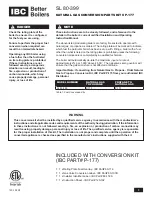
43
LP- 325 REV. 3.3.15
3. INDOOR COMBUSTION AIR INSTALLATION IN CONFINED OR UNCONFINED SPACE
This appliance requires fresh, uncontaminated air for safe operation and must be installed in a mechanical room where there is
adequate combustion and ventilating air.
NOTE: To prevent combustion air contamination, see Table 1.
Combustion air from the indoor space can be used if the space has adequate area or when air is provided through a duct or louver to
supply sufficient combustion air based on the appliance input.
Never obstruct the supply of combustion air to the appliance.
If the
appliance is installed in areas where indoor air is contaminated (see Figure 19) it is imperative that the appliance be installed as direct
vent so that all combustion air is taken directly from the outdoors into the appliance intake connection.
Unconfined space
is space with volume greater than 50 cubic feet per 1,000 Btu/hour (4.8 cubic meters per kW) of the total input
rating of all fuel-burning appliances installed in that space. Rooms connected directly to this space, through openings not furnished with
doors, are considered part of the space.
Confined space
is space with volume less than 50 cubic feet per 1,000 Btu/hour (4.8 cubic meters per kW) of the total input rating of
all fuel-burning appliances installed in that space. Rooms connected directly to this space, through openings not furnished with doors,
are considered part of the space.
When drawing combustion air from inside a conventionally constructed building to a confined space, such space should be provided
with two permanent openings: one located 6” (15 cm) below the space ceiling, the other 6” (15cm) above the space floor. Each opening
should have a free area of one square inch per 1,000 Btu/hr (22cm
2
/kW) of the total input of all appliances in the space, but not less
than 100 square inches (645cm
2
).
If the confined space is within a building of tight construction, air for
combustion must be obtained from the outdoors as outlined in the Venting
section of this manual. See
Figure 20
.
Figure 19
– LP-325-X
Summary of Contents for Pioneer
Page 17: ...17 LP 325 REV 3 3 15 Figure 3 Dimensions ...
Page 28: ...28 LP 325 REV 3 3 15 Figure 9 DHW Pack Performance on 199K BTU Models ...
Page 44: ...44 LP 325 REV 3 3 15 Figure 20 ...
Page 47: ...47 LP 325 REV 3 3 15 Figure 22 Internal Wiring Diagram ...
Page 67: ...67 LP 325 REV 3 3 15 Figure 30 Pioneer and Versa Flame ...
Page 68: ...68 LP 325 REV 3 3 15 Figure 31 Pioneer and Versa Flame ...
Page 71: ...71 LP 325 REV 3 3 15 ...
Page 72: ...72 LP 325 REV 3 3 15 ...
















































